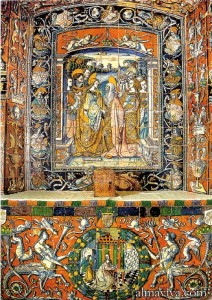Francisco Niculoso (circa 1470 – 1529), said Niculoso Pisano, is an Italian maiolica painter of the Renaissance.
He settled in Seville, Spain, in 1498, a few years after the end of the Reconquista and the discovery of America. He introduced in Spain the Italian technique of painting on an unbaked white tin glaze, a technique known as maiolica in Italy. He enabled the evolution of the Hispano-Moresque art of azulejos tiles from geometric patterns into the representation of sceneries.
Niculoso painted ceramic panels that are true works of art; they are often signed with his name. Some of them can still be admired in their original places in Seville. For instance the chapel of the Alcazar, a complete tile-work commissioned by the Catholic monarchs Isabella and Ferdinand (see below). Other examples are the church of Santa Ana in Triana, a borough of Seville, and the monastery of Santa Paula. Some of his tiles can be also admired in the Rijksmuseum of Amsterdam.





